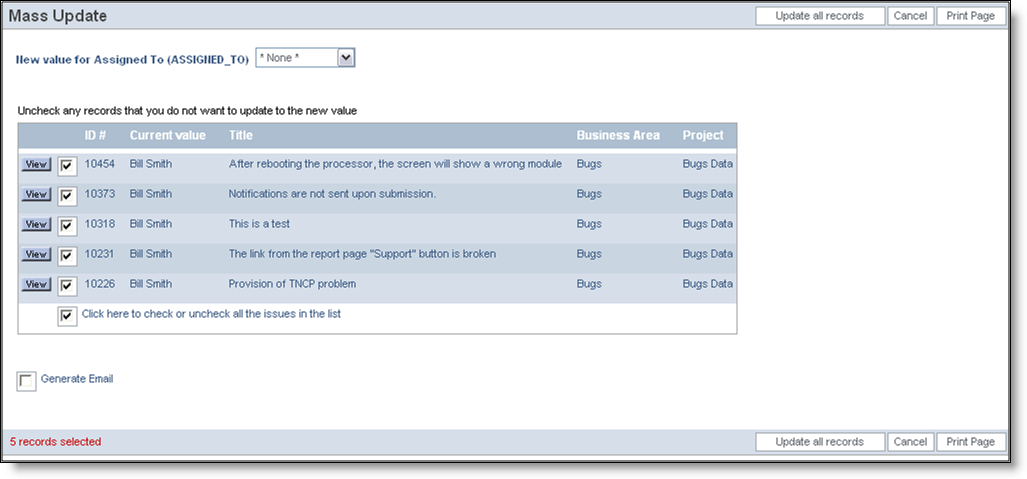Assuming the administrator has given you permission, there will be a button labeled Update Issues on Quicklist Reports, Detailed Reports and Custom Reports that you generate. This button allows the batch or mass update of a list of fields available to you. For example, you may want to re-assign all the open issues assigned from one person to a different person. Another example may be to move a range of issues open against a specific release to another future release of the product. Not all fields can be updated by this method. Only fields to which you have write access, and fields that are of display type List, Pop-up, Tab, User, Checkbox, Text and Number can be updated. In addition, if a field is subject to special treatment or processing that has been set up by your administrator, it will not be available for updating by this method. If you are using the ExtraView feature that allows multiple repeating records to be creating against each issue, then the fields on the repeating records cannot be updated with this facility. To use this feature:
Note: If the field you are updating is a multi-valued field or part of a repeating record that can have many values, then the update will add the new value to the existing list of values for the field you are updating.
Note: You may not be able to undo this mass update operation, so take care before pressing the Update button.
Note: Allowed value combinations are not used within the Mass Update feature. It is the responsibility of the user to select valid allowed value combinations when selecting values from the lists in the Mass Update screen. If an incorrect combination is selected and the user proceeds with the mass update, then it will fail.
Note: You may update issues across multiple business areas and projects, provided the value to be updated does not violate any business rule such as a field being required. Example: This shows how you can reassign all open issues from one person to another, for a given product: Prepare a Quicklist report that selects Business Area = Bugs and Status = Open and Assigned To a specific user as filters. From the resulting report output, press the Update Issues button. You will see a screen similar to:

Selecting a field to update
Select the Assigned To field from the list and the screen will redisplay, showing something similar to:

Mass update screen
From the select list labeled New value for Assigned To, select the person you want to reassign the issues to. You can view any of the issues to check whether they should be part of the update, and you can uncheck any or all of the issues. If the field you are trying to update is dependent upon another field (for example a module field may be dependent upon product), then you will be prompted for the parent field, then the child field, to ensure that the relationships between the values are kept intact and only valid combinations are stored. If you try to update a parent field that would invalidate the child records, for example trying to set the product field to a value that is not appropriate for a given module, you will receive an error for that issue, or issues, and these issues will not be updated.
Note: You can only update issues that are within your currently set Business Area and Project. If your search results contained any issues, or items in any other Business Area or Project of the system, they will not be updated. When ready, you can press the Update all records button. You will be asked to confirm that you want to update the issues. Expect the update to take one – two seconds per issue to perform the update. Updating the issues is a process that happens in the “background” of the computer server. This has a number of advantages. First, it makes the mass update process less prone to error conditions if your local computer malfunctions or crashes midway through the process, or the communications network is disrupted for some reason. Second, managing the mass update as a background process allows ExtraView to monitor for attempts for one user, or several users to start mass updates while other mass updates are still running. This can lead to data integrity or data corruption problems, and of course is highly undesirable. While the mass update is underway, you will see a progress window as follows:

Mass update progress bar
Note: Pressing the button to hide the progress bar, or closing the window has no effect on the execution of the mass update. As a background process, it will continue. The progress bar is purely for informative purposes. Once the mass update is complete, and assuming you have not closed the progress window, you will see a summary of the mass update, including any errors encountered. The most common error is trying to perform a global mass update across several business areas, when the field you are trying to update is not on the edit screen for the business area and project to which the issue belongs.

Results of a mass update, showing errors
Multi-Valued fields are treated differently for the purpose of mass update. When you select one or more values in a multi-valued field to be updated, the selected values are added to the current values within the field. The existing field values remain untouched. If you want to replace the values in the field, first mass update the multi-valued field to a value of * None *, then perform the update you want to add the values to the field.
Mass update works with repeating rows, but there are a couple of points to consider: